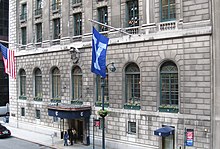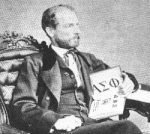| Delta Kappa Epsilon | |
|---|---|
| ΔΚΕ | |
 |
|
| Founded | June 22, 1844 No. 12 Old South Hall, Yale University, New Haven,Connecticut |
| Type | Social |
| Scope | International |
| Motto | Kerothen Philoi Aei
(“Friends From The Heart, Forever”) |
| Colors | Azure(Blue/Navy), Or (Gold), and Gules (Crimson) |
| Symbol | Rampant Lion |
| Publication | The Deke Quarterly |
| Philanthropy | Rampant Lion Foundation |
| Chapters | 54 |
| Headquarters | P.O. Box 8360 Ann Arbor, Michigan, USA |
| Homepage | http://www.dke.org |
Delta Kappa Epsilon (ΔΚΕ; also pronounced D-K-E or “Deke”) is one of the oldest North American fraternities with 54 active chapters across the United States and Canada. The fraternity was founded at Yale College in 1844 by 15 sophomores that were disaffected by the existing houses on campus. They established a fellowship “where the candidate most favored was he who combined in the most equal proportions the gentleman, the scholar, and the jolly good fellow.”
The private gentleman’s club the DKE Club of New York was founded in 1885 and is currently in residence at the Yale Club of New York City.
Founding[edit]
The fraternity was founded June 22, 1844,[1] in room number 12 Old South Hall, Yale College, New Haven, Connecticut. At this meeting, the Fraternity’s secret and open Greek mottos were devised, as were the pin and secret handshake. The open motto is “Kerothen Philoi Aei” (“Friends from the Heart, Forever”).
The fifteen founders were:[2] William Woodruff Atwater, Dr. Edward Griffin Bartlett, Frederic Peter Bellinger, Jr., Henry Case, Colonel George Foote Chester, John Butler Conyngham, Thomas Isaac Franklin, William Walter Horton, The Honorable William Boyd Jacobs, Professor Edward VanSchoonhoven Kinsley, Chester Newell Righter, Dr. Elisha Bacon Shapleigh, Thomas DuBois Sherwood, Albert Everett Stetson, and Orson William Stow. This first Chapter was denoted Phi chapter.
The Objects of Delta Kappa Epsilon are:
- The Cultivation of General Literature and Social Culture, the Advancement and Encouragement of Intellectual Excellence, the Promotion of Honorable Friendship and Useful Citizenship, the Development of a Spirit of Tolerance and Respect for the Rights and Views of Others, the Maintenance of Gentlemanly Dignity, Self-Respect, and Morality in All Circumstances, and the Union of Stout Hearts and Kindred Interests to Secure to Merit its Due Reward.[3]
Delta Kappa Epsilon administers a charitable organization called the Rampant Lion Foundation. DKE also has championed an organization call Restore Our Associational Rights (“ROAR”) which campaigns for the freedom of fraternities and Greek organizations in general to operate without interference and discrimination from university administrations or others.
The pin of Delta Kappa Epsilon shows the Greek letters ΔΚΕ on a white scroll upon a black diamond with gold rope trim and a star in each corner. DKE’s heraldic colours are azure (blue), or (gold), and gules (crimson). Its flag is a triband of those colours with a dexter rampant lion in the middle.
Chapters[edit]
Within three years of the founding at Yale, chapters were founded at Bowdoin,Princeton University, Colby College, and Amherst College. DKE has grown to 54 chapters and has initiated over 85,000 members across North America.
Traditionally an Eastern Seaboard fraternity, DKE’s Yale chapter had an early reputation as a Southerner’s fraternity. Two of the original founders were from the South and 13 out of 38 members of 1845 and 1846 were from the South. AlthoughVanderbilt University claims DKE’s first chapter in the South (Gamma chapter, supposedly founded in 1847), Vanderbilt University was not founded until 1873. Psi chapter at the University of Alabama was founded in 1847.
Syracuse University‘s chapter house was used as a safe harbor by Harriet Tubman,Sojourner Truth, and William Still during passage into Canada via the Underground Railroad.
Delta Kappa Epsilon’s first West Coast chapter was founded at the University of California, Berkeley on Halloween night, 1876. The DKE chapter at Colgate University (Hamilton, NY) is one of the only DKE chapters having a Temple building, one which only can be entered by Mu DKE members. The Lambda Chapter at Kenyon College in 1854 built the first fraternity lodge in America. The Delta Kappa Epsilon Club of New York was founded in 1885 and is currently in residence at the Yale Club of New York City.[4] Delta Kappa Epsilon became an international fraternity with the addition of the Alpha Phi chapter in 1898 at the University of Toronto, Canada.
As of May 2014, Delta Kappa Epsilon has twelve colonies, at University of South Carolina, McGill University (Montreal), University of Illinois, University of Texas, North Carolina State, Hampden-Sydney College, University of Delaware, Simon Fraser University, University of Edinburgh, Ithaca College, University of Oxford, and the University of Tennessee. However, both Edinburgh and Oxford have said they were “not aware” of the fraternity’s activities on their campuses, and Edinburgh formally requested that the university’s crest was not used by the fraternity.[5]
Notable members[edit]
President Theodore Roosevelt
Delta Kappa Epsilon members have included five of forty-four Presidents of the United States: Rutherford B. Hayes, Theodore Roosevelt, Gerald Ford, George H. W. Bush, and George W. Bush. Vice President of the United States, Dan Quayle, became a DKE brother at DePauw University. Franklin D. Roosevelt was a member of the Alpha Chapter of DKE at Harvard and would be considered the sixth DKE brother to serve as President of the United States; however, the Harvard chapter was de-recognized by DKE International due to the chapter’s stance on dual membership with other fraternities.
In the election of 1876, the Republican Party chose between two DKE members, nominating Hayes rather than rival and fellow DKE James G. Blaine. Blaine also ran unsuccessfully for President.
Many American and Canadian politicians, businessmen, sports figures, and artists have been members, including Joe Paterno, Herb Kelleher, J.P. Morgan, Jr.,William Randolph Hearst, Cole Porter, Henry Cabot Lodge, Dick Clark, Tom Landry, and George Steinbrenner. DKE flags were carried to the North Pole by its discoverer, Admiral Robert Peary and to the Moon by astronaut Alan Bean.
During the Civil War, the first Union officer killed in battle was DKE member Theodore Winthrop of Phi. The dying Edwin S. Rogers (Theta) of Maine was attended to by a Confederate Psi from Alabama, who observed the DKE pin and sent it to the family.[6] During the Spanish–American War, the first American officer to be killed was a DKE member, Surgeon John B. Gibbs (Phi Chi). DKE member J. Frank Aldritch (Psi Phi) died when the USS Maine was sunk.
Yung Wing, the first Chinese graduate from an American university in 1854, was a member of the Phi Chapter of DKE. Later, his citizenship was revoked and he was denied reentry to the United States by the government of Theodore Roosevelt, another member of DKE.
The late Dick Clark donated $1 million to the Delta Kappa Epsilon Foundation of Central New York, which handles finances for the fraternity’s chapters across the U.S.[7]
Purpose of Chapters[edit]
One of Delta Kappa Epsilon’s focuses within each Chapter is on community service in addition to the social aspect that goes along with most collegiate academic Greek fraternities.
Each Chapter competes for a number of awards that include leadership, chapter improvements, and community service.[8]Each of these areas is used in awarding the overall award called the Lion Trophy.
The 2011 Lion Trophy winner was Psi chapter at the University of Alabama.[9] The chapter won this award in the wake of sponsoring a food drive to help give relief to the Tuscaloosa community devastated by tornadoes.[10] The 2012 winner of the Lion Trophy was the University of British Columbia, and 2013’s Lion Trophy went to both the Psi chapter and the Iota chapter at Centre College.
Controversy[edit]
On June 6, 1892, a pledge was led blindfolded through the street during his fraternity initiation towards Moriarty’s Cafe, a popular student hang-out. He was told to run and did so at top speed. He ran into a sharp carriage pole, injuring himself. He was rendered unconscious, but the injury was not thought to be serious at the time. He suffered an intestine rupture and died five days later of peritonitis.[11][12][13][14]
In 1967, the New York Times reported on “frat-branding”—the alleged use of a hot branding iron to make a “D” shaped scar on new fraternity members. The fraternity’s then-president George W. Bush stated that they were “only cigarette burns.”[15]
In 1989, Colgate University banned all DKE activities after the officials found members guilty of hazing, blackballing and other violations of university regulations.[16] In 2005 Colgate University barred DKE from campus for refusing to sell its house to the school and join a new student-residence initiative. DKE filed a lawsuit charging that the school violated its right to free association as well as antitrust laws by monopolizing the student housing market.[17] In 2006 the Supreme Court of Madison County found that the fraternity had failed to state a cause of action and that its claim was “time-barred.”[18][19]
In December, 2008, the University of California, Berkeley dechaptered the local DKE chapter for alcohol, hazing and fire safety misconduct.[20] The chapter never closed, and continued in “rogue” status. Four years later, the chapter opted not to reapply for University recognition and continue as a rogue fraternity. In 2012, the chapter was visited by County Vice Enforcement Team for complaints about under-age drinking.[21] And on October 17, there were reports of 5 sex assaults at this chapter. The five individuals reported that they had been given “roofies” and sexually assaulted, however the reports went unconfirmed and no charges were pressed against the chapter nor its members.[22]
In October 2010, Yale’s DKE chapter came under fire after its members shouted inflammatory and misogynistic chants at an Old Campus pledge ritual.[23] These chants included, “No means yes, yes means anal.” and “My name is Jack. I’m a necrophiliac. I f— dead women and fill them with my semen.” The chapter’s president, Jordan Forney, apologized for the fraternity’s conduct, characterizing it as a “lapse in judgment.”[24] but Yale’s feminist magazine Broad Recognition called for administrative action against the leadership of DKE. By October 24, 2010, Dean Mary Miller of Yale College had strongly recommended to the DKE National Executive Director, Dr. Douglas Lanpher, that the chapter at Yale be put on probation indefinitely.[25] Instead, on May 17, 2011, the chapter was put on suspension for five years.[26] The order bars DKE from conducting any activities on the Yale campus during that time.[27]
In January 2011, the DKE chapter at the University of Alberta had its student group status suspended for three years due to alleged hazing activity.[28]
In November 2014, a DKE chapter in Edinburgh had the minutes leaked from a meeting in March 2014 by the University of Edinburgh student newspaper, The Student. The minutes allegedly made reference to comments that joked about raping the Edinburgh University Feminist Society.[29] The story gained traction in both national and international media, being picked up by The Independent, The Huffington Post, and Time magazine.





